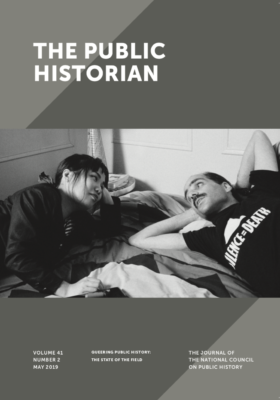Editor’s Corner: Commemorating Queer History
27 May 2019 – James F. Brooks

The cover image of the May 2019 issue of “The Public Historian” is part of a 1987 book project following people with AIDS and their caregivers. It was featured in “AIDS at Home: Art and Everyday Activism,” a 2017 exhibition at the Museum of the City of New York. The exhibition sought to emphasize the centrality of domestic space in the history of HIV/AIDS. See Stephen Vider, “Public Disclosures of Private Realities: HIV/AIDS and the Domestic Archive,” in this issue. Photo credit: Susan Kuklin, “Kachin and Michael at Michael’s apartment, 1987.” Used with permission.
This special issue, guest-edited by historian Melinda Marie Jetté and timed to commemorate the fiftieth anniversary of the Stonewall uprising in New York City, sparked a query among our editorial alumni and archives to identify just when The Public Historian first embraced the lives of LGBTQ people among our public history constituents.
It seems the earliest reference appeared in 1983, when Konrad Hamilton, writing as a graduate student in Public Historical Studies at UCSB, raised the issue of gay rights in his review of David Tyack and Elizabeth Hansot’s 1982 Managers of Virtue: Public School Leadership in America (Basic, 1982). This was followed in 1987 by Todd Shallat’s review of Susan Porter Benson, Stephen Brier, and Roy Rosenzweig’s now-classic volume Presenting the Past: Essays on History and the Public (Temple University Press, 1986), which featured Lisa Duggan’s essay “History’s Gay Ghetto: The Contradictions of Growth in Lesbian and Gay History.”
The Public Historian, then, at least attended to the historiographical curve that Jetté details so gracefully in her opening essay, “Through the Queer Looking Glass.” The ferocity of sexual politics in the 1980s and 1990s echoed the violence of Stonewall in 1969 but occurred at the state level in Oregon and California, where some of the earliest organizing and archiving efforts faced stiff and often ugly resistance from anti-gay activists and politicians. It wasn’t until 2010 that the journal showcased LGBTQ public history in a “Report from the Field” from Lauren Jae Gutterman, “OutHistory.org: An Experiment in LGBTQ Community History-Making.” Gutterman served as project coordinator of OutHistory.org, a website founded by Jonathan Ned Krantz in 2003 to showcase lesbian, gay, bisexual, transgender, and queer history, now hosted at The New School. In her report, Gutterman detailed how OutHistory.org used MediaWiki software to compile community-created histories of LGBTQ life in the United States and make the insights of the queer experience available to broad audiences beyond our classrooms. The website, Gutterman explained, employed public digital history to collect, advance, and project LGBTQ history, serving as a model for other interactive history web sites.
The twelve essays Jetté has gathered tell a story now a half-century deep. They follow the struggle to unite often-disparate regions, identity groups, political goals and strategies toward national, and international, recognition and civil rights. Ranging from autobiography to oral history, from archival creation and curation strategies to heritage and historic preservation, even to street-level direct action and the universality of human rights embedded in those efforts, she and her contributors have crafted a collection we believe will serve well even a half-century hence.
~ James Brooks is editor of The Public Historian and professor of history and anthropology at the University of California, Santa Barbara.



